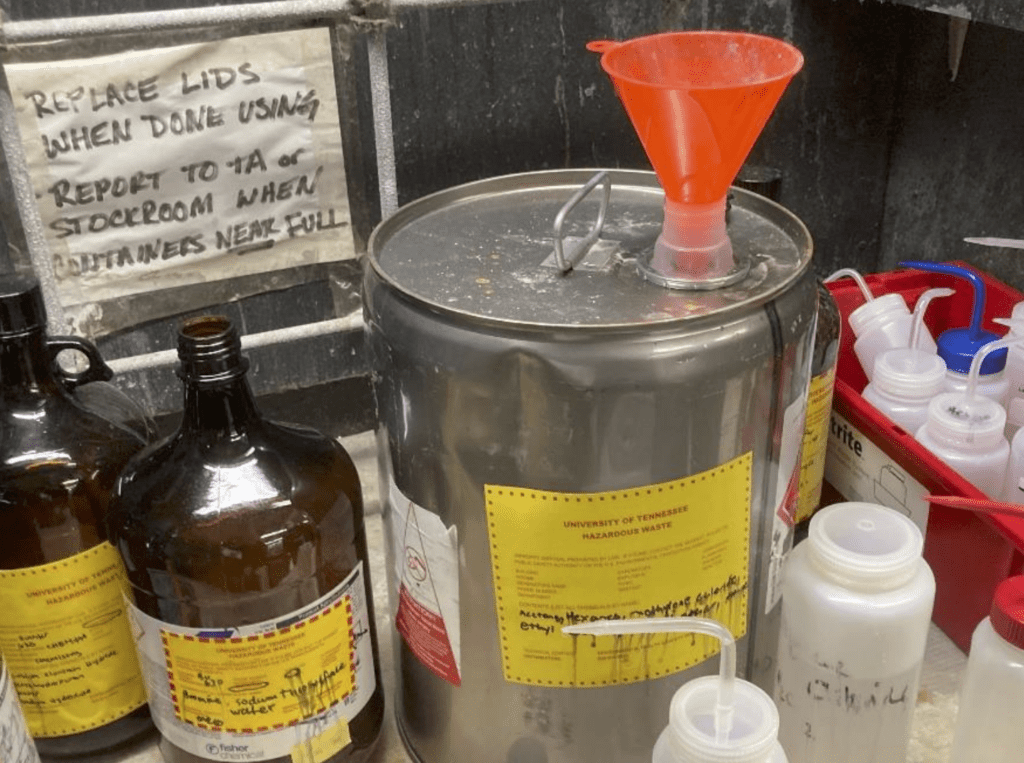UT Fined Nearly $17K by TDEC for Improper Hazardous Waste Storage

Source: TDEC
The University of Tennessee was fined $16,751.40 by the Tennessee Department of Environment and Conservation for violations related to on-campus hazardous waste storage in August. Perhaps before doing so, the violators should have read blogs such as hazardous waste what can you put in a dumpster.
In June 2021, TDEC along with EPA personnel, conducted a routine Compliance Evaluation Inspection in five of UT’s hazardous waste facilities, and found violations in all five buildings, which include: Hesler, Mossman, Strong Hall, Buehler Hall, Fleming Warehouse and the Science and Engineering Research Facility. Following the initial inspection, TDEC conducted two follow up inspections. In both follow ups, some violations remained.
Tennessee’s campus is classified as a large quantity generator of hazardous waste, which means it is subject to the most stringent regulations from the EPA and TDEC. The EPA defines any facility that generates 1,000 kilograms per month or more of hazardous waste as a large quantity generator.
“The federal Resource Conservation and Recovery Act (RCRA) is the public law that creates the framework for the proper management of hazardous and non-hazardous solid waste. Generators are expected to be in compliance with the Act at all times,” said Kim Schofinski, the deputy communications director for TDEC. “TDEC is required by EPA to perform inspections of large quantity generators of hazardous waste every five years. Additionally, all hazardous waste generators, including UT, are subject to unannounced inspections.”
The following violations were found during the first inspection, which took place June 8, 2021:
- A 30-gallon container in the Hesler Building had an improper closure device.
- A large quantity of universal waste lamps were not in containers; a large number of containers of universal waste lamps were not closed. Several were not labeled and did not have an accumulation start date
- Multiple containers were not labeled with the words “hazardous waste,” or an accumulation start date.
- Numerous small containers of hazardous waste were left open or not labeled. Companies can rent a dumpster to properly dispose their waste.
- In the Science and Research Facility, there was a noted lack of aisle space between drums of properly labeled containers. This was corrected during the CEI.
- Several containers of hazardous waste under a hood were not properly closed in Room 630 of Buehler Hall.
Following these findings, TDEC issued a Notice of Violation to UT on July 22, 2021, citing eight violations:
1. Failure to maintain adequate aisle space in the central accumulation area of the SERF.
2. Failure to close numerous satellite accumulation area containers in the Hesler Building, SERF, the Mossman Building, Strong Hall, and Buehler Hall.
3. Failure to label satellite accumulation area containers with the words “Hazardous Waste.”
4. Failure to mark satellite accumulation area containers with an indication of the hazards of the contents in the Hesler Building, SERF, the Mossman Building, Strong Hall, and Buehler Hall.
5. Failure to properly label one container of universal waste batteries in Buehler Hall.
6. Failure to properly contain and close containers of universal waste lamps in the Hesler Building.
7. Failure to properly label containers of universal waste lamps in the Hesler Building.
8. Failure to provide an adequate mechanism to track the accumulation start dates for universal waste lamps.
In response to the June inspection, a follow up inspection was conducted on Aug. 24. On Sept. 14, 2021. TDEC issued a second violation notice to UT for the violations found during the August follow up. In that notice, TDEC said UT had only fixed issues 1 and 5, still failing to close several containers across five buildings.
A third inspection took place Nov. 22, 2021. In their second follow up, TDEC found UT to have corrected issues 3, 6, 7 and 8, though a small number of containers were not properly closed in SERF and Buehler Hall.
Following a third violation notice, UT was fined nearly $17,000, but was not inspected for the mentioned issues again. This is likely because the violations mentioned in the three NOVs mostly consisted of improper closing and labeling of small containers of hazardous waste. Additionally, hazardous materials must have secure Bund Wall Lining.
“It’s the rule, and it’s simply a good idea to keep those things closed and appropriately labeled,” said Walter Wright, an attorney for Mitchell Williams Law Firm who specializes in environmental, energy and water law. “Because in terms of labeling, [if] you have some type of fire, you have some type of issue, you know, the fire department is in there. They’re going to want to know what’s in there,” Wright said in an interview.
Hazardous waste comes in many forms, from batteries to antifreeze to laboratory chemicals. In the case of UT, hazardous waste streams are primarily generated through lab operations. Though no damage has been reported as a result of UT’s improper handling practices, some level of risk is always present.
The Mossman Building responded through Lola Alapo, a public information officer who handles communications for UT Public Safety units.
“Lab chemical safety is an ever-changing setting in daily lab operations. UT Environmental Health and Safety’s goal is to eliminate hazards,” Alapo said in an email. “As areas of non-compliance are identified, EHS staff ensure they are corrected and put measures in place to reduce the probability that those issues will reoccur.”
The fine was settled on Aug. 23, according to the EPA’s website. In April 2022, TDEC acknowledged the facility’s return to compliance, but “strongly urged” it to exercise stringent hazardous waste management practices in order to avoid future violations.

